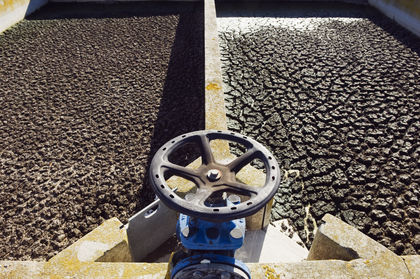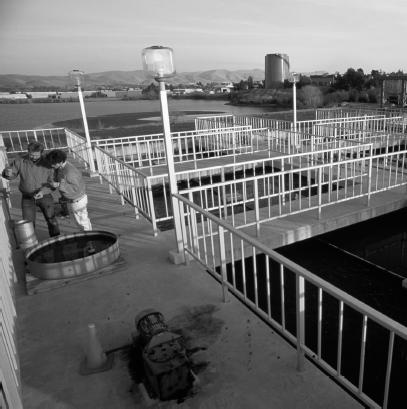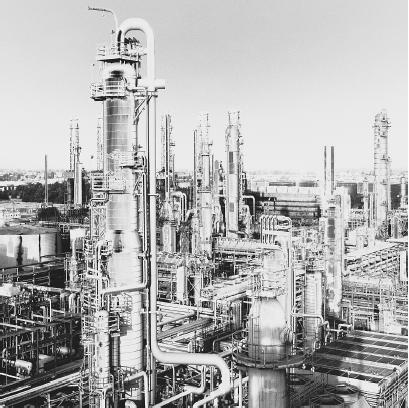Distillation and Filtration - Real-life applications

Distillation
In distillation, the more volatile component of the mixture—that is, the part that is more easily vaporized—is separated from the less volatile portion. With regard to the illustration used above, of separating water from salt, clearly the water is the more volatile portion: its boiling point is much, much lower than that of salt, and the heat required to vaporize the salt is so great that the water would be long since vaporized by the time the salt was affected.
Once the volatile portion has been vaporized, or turned into distillate, it experiences condensation—the cooling of a gas to form a liquid, after which the liquid or condensate is collected. Note that in all these stages of distillation, heat is the agent of separation. This is especially important in the process of fractional distillation, discussed below.
The process of removing water vapor from salt water, described earlier, is an example of what is called "single-stage differential distillation." Sometimes, however—especially when a

PURIFIED WATER AND ETHANOL.
If distillation can be used to separate water from salt, obviously it can also be used to separate water from microbes and other impurities through a more detailed process of rectification. Distilled water, purchased for drinking and other purposes, is just one of the more common applications of the distillation process. Another well-known use of this process is the production of ethyl alcohol, made famous (or perhaps infamous) by stories of bootleggers producing homemade whiskey from "stills" or distilleries in the woods.
Ethanol, the alcohol in alcoholic beverages, is produced by the fermentation of glucose, a sugar found in various natural substances. The choice of substances is a function of the desired product: grapes for wine; barley and hops for beer; juniper berries for gin; potatoes for vodka, and so on. Glucose reacts with yeast, fermenting to yield ethanol, and this reaction is catalyzed by enzymes in the yeast. The reaction continues until the alcohol content reaches a point equal to about 13%.
After that point, the yeast enzymes can no longer survive, and this is where the production of beer or wine usually ends. Fortified wine or

Distillation constitutes the second stage in the production of alcohol. Often, the fermentation products are subjected to a multistage rectification process, which yields a mixture of up to 95% ethanol and 5% water. This mixture is called an azeotrope, meaning that it will not change composition when distilled further. Usually the production of whiskey or other liquor stops well below the point of yielding an azeotrope, but in some states, brands of grain alcohol at 190 proof (95%) are sold.
INDUSTRIAL DISTILLATION.
In contrast to ethanol, methanol or "wood alcohol" is a highly toxic substance whose ingestion can lead to blindness or death. It is widely used in industry for applications in adhesives, plastics, and other products, and was once produced by the distillation of wood. In this old production method, wood was heated in the absence of air, such that it did not burn, but rather decomposed into a number of chemicals, a fraction of which were methanol and other alcohols.
The distillation of wood alcohol was abandoned for a number of reasons, not least of which was the environmental concern: thousands of trees had to be cut down for use in an inefficient process yielding only small portions of the desired product. Today, methanol is produced from synthesis gas, itself a product of coal gasification; nonetheless, numerous industrial processes use distillation.
Distillation is employed, for instance, to separate the hydrocarbons benzene and toluene, as well as acetone from acetic acid. In nuclear power plants that require quantities of the hydrogen isotope deuterium, the lighter protium isotope, or plain hydrogen, is separated from the heavier deuterium by means of distillation. Few industries, however, employ distillation to a greater degree than the petroleum industry.
Through a process known as fractional distillation, oil companies separate hydrocarbons from petroleum, allowing those of lower molecular mass to boil off and be collected first. For instance, at temperatures below 96.8°F (36°C), natural gas separates from petroleum. Other substances, including petroleum ether and naphtha, separate before the petroleum reaches the 156.2°F-165.2°F (69°C-74°C) range, at which point gasoline separates.
Fractional distillation continues, with the separation of other substances, all the way up to 959°F (515°C), above which tar becomes the last item to be separated. Petroleum and petroleum-product companies account for a large portion of the more than 40,000 distillation units in operation across the country. About 95% of all industrial separation processes involve distillation, which consumes large amounts of energy; for that reason, ever more efficient forms of distillation are continually being researched.
Filtration
In the simplest form of filtration, described earlier, a suspension (solid particles floating in a liquid) is allowed to pass through filter paper supported in a glass funnel. The filter paper traps the solid particles, allowing a clear solution (the filtrate) to pass through the funnel and into a receiving container.
There are two basic purposes for filtration: either to capture the solid material suspended in the fluid, or to clarify the fluid in which the solid is suspended. An example of the former occurs, for instance, when panning for gold: the water is allowed to pass through a sieve, leaving behind rocks that—the prospector hopes—contain gold. An example of the latter occurs in sewage treatment. Here the solid left behind is feces—as undesirable as gold is desirable.
Filtration can further be classified as either gaseous or liquid, depending on which of the fluids constitutes the filtrate. Furthermore, the force that moves the fluid through the filter—whether gravity, a vacuum, or pressure—is another defining factor. The type of filter used can also serve to distinguish varieties of filtration.
LIQUID FILTRATION.
In liquid filtration, such as that applied in sewage treatment, a liquid can be pulled through the filter by gravitational force, as in the examples given. On the other hand, some sort of applied pressure, or a pressure differential created by the existence of a vacuum, can force the liquid through the filter.
Water filtration for purification purposes is often performed by means of gravitation. Usually, water is allowed to run down through a thick layer of granular material such as sand, gravel, or charcoal, which removes impurities. These layers may be several feet thick, in which case the filter is known as a deep-bed filter. Water purification plants may include fine particles of charcoal, known as activated carbon, in the deep-bed filter to absorb unpleasant-smelling gases.
For separating smaller volumes of solution, a positive-pressure system—one that uses external pressure to push the liquid through the filter—may be used. Fluid may be introduced under pressure at one end of a horizontal tank, then forced through a series of vertical plates covered with thick filtering cloths that collect solids. In a vacuum filter, a vacuum (an area virtually devoid of matter, including air) is created beneath the solution to be filtered, and as a result, atmospheric pressure pushes the liquid through the filter.
When the liquid is virtually freed of impurities, it may be passed through a second variety of filter, known as a clarifying filter. This type of filter is constructed of extremely fine-mesh wires or fibers designed to remove the smallest particles suspended in the liquid. Clarifying filters may also use diatomaceous earth, a finely powdered material produced from the decay of marine organisms.
GAS FILTRATION.
Gas filtration is used in a common appliance, the vacuum cleaner, which passes a stream of dust-filled air through a filtering bag inside the machine. The bag traps solid particles, while allowing clean air to pass back out into the room. This is essentially the same principle applied in air filters and even air conditioning and heating systems, which, in addition to regulating temperature, also remove dust, pollen, and other impurities from the air.
Various industries use gas filtration, not only to purify the products released into the atmosphere, but also to filter the air in the workplace, as for instance in a factory room where fine airborne particles are a hazard of production. The gases from power plants that burn coal and oil are often purified by passing them through filtering systems that collect particles.
Sewage Treatment
Sewage treatment is a complex, multistage process whereby waste water is freed of harmful contents and rendered safe, so that it can be returned to the environment. This is a critical part of modern life, because when people congregate in cities, they generate huge amounts of wastes that contain disease-causing bacteria, viruses, and other microorganisms. Lack of proper waste management in ancient and medieval times led to devastating plagues in cities such as Athens, Rome, and Constantinople.
Indeed, one of the factors contributing to the end of the Athenian golden age of the fifth century B.C. was a plague, caused by lack of proper sewage-disposal methods, that felled many of the city's greatest figures. The horrors created by improper waste management reached their apogee in 1347-51, when microorganisms carried by rats brought about the Black Death, in which Europe's population was reduced by one-third.
AEROBIC AND ANAEROBIC DECAY.
Small amounts of sewage can be dealt with through aerobic (oxygen-consuming) decay, in which microorganisms such as bacteria and fungi process the toxins in human waste. With larger amounts of waste, however, oxygen is depleted and the decay mechanism must be anaerobic, or carried out in the absence of oxygen.
For people who are not connected to a municipal sewage system, and therefore must rely on a septic tank for waste disposal, waste products pass through a tank in which they are subjected to anaerobic decay by varieties of microorganisms that do not require oxygen to survive. From there, the waste goes through the drain field, a network of pipes that allow the water to seep into a deep-bed filter. In the drain field, the waste is subjected to aerobic decay by oxygen-dependant microorganisms before it either filters through the drain pipes into the ground, or is evaporated.
MUNICIPAL WASTE TREATMENT.
Municipal waste treatment is a much more involved process, and will only be described in the most general terms here. Essentially, large-scale sewage treatment requires the separation of larger particles first, followed by the separation of smaller particles, as the process continues. Along the way, the sewage is chemically treated as well. The separation of smaller solid particles is aided by aluminum sulfate, which causes these particles to settle to the bottom more rapidly.
Through continual processing by filtration, water is eventually clarified of biosolids (that is, feces), but it is still far from being safe. At that point, all the removed biosolids are dried and incinerated; or they may be subjected to additional processes to create fertilizer. The water, or effluent, is further clarified by filtration in a deep-bed filter, and additional air may be introduced to the water to facilitate aerobic decay—for instance, by using algae.
Through a long series of such processes, the water is rendered safe to be released back into the environment. However, wastes containing extremely high levels of toxins may require additional or different forms of treatment.
WHERE TO LEARN MORE
"Case Study: Petroleum Distillation" (Web site). <http://www.pafko.com/history/h_distill.html> (June 6, 2001).
"Classification of Matter" (Web site). <http://www.cards.anoka.k12.mn.us/projects/html> _98/smith/smith2. ht ml (June 6, 2001).
"Fractional Distillation" (Web site). <http://www.geocities.com/chemforum/fdistillation.htm> (June 6, 2001).
"Introduction to Distillation" (Web site). <http://lorien.ncl.ac.uk/ming/distil/distil0.htm> (June 6, 2001).
Kellert, Stephen B. and Matthew Black. The Encyclopedia of the Environment. New York: Franklin Watts, 1999.
Oxlade, Chris. Chemistry. Illustrated by Chris Fairclough. Austin, TX: Raintree Steck-Vaughn, 1999.
Seuling, Barbara. Drip! Drop! How Water Gets to Your Tap. Illustrated by Nancy Tobin. New York: Holiday House, 2000.
"Sewage Treatment" (Web site). <http://www.dcs.exeter.ac.uk/water/sewage.htm> (June 6, 2001).
Zumdahl, Steven S. Introductory Chemistry: A Foundation, 4th ed. Boston: Houghton Mifflin, 2000.